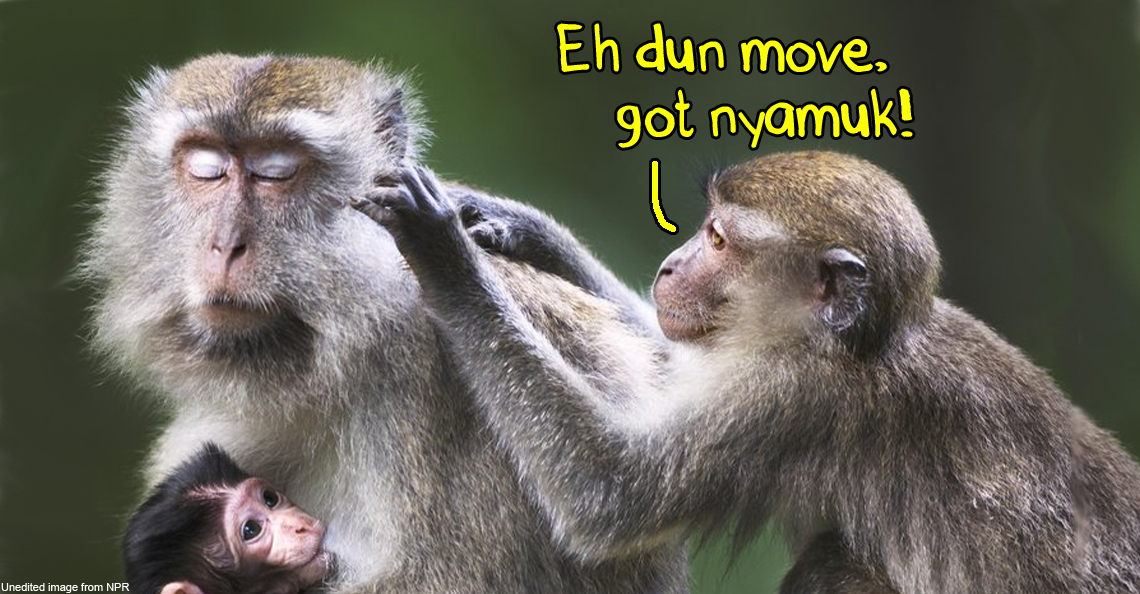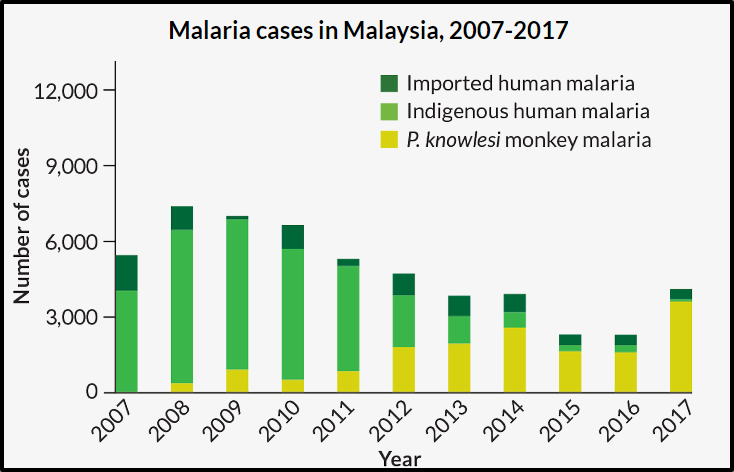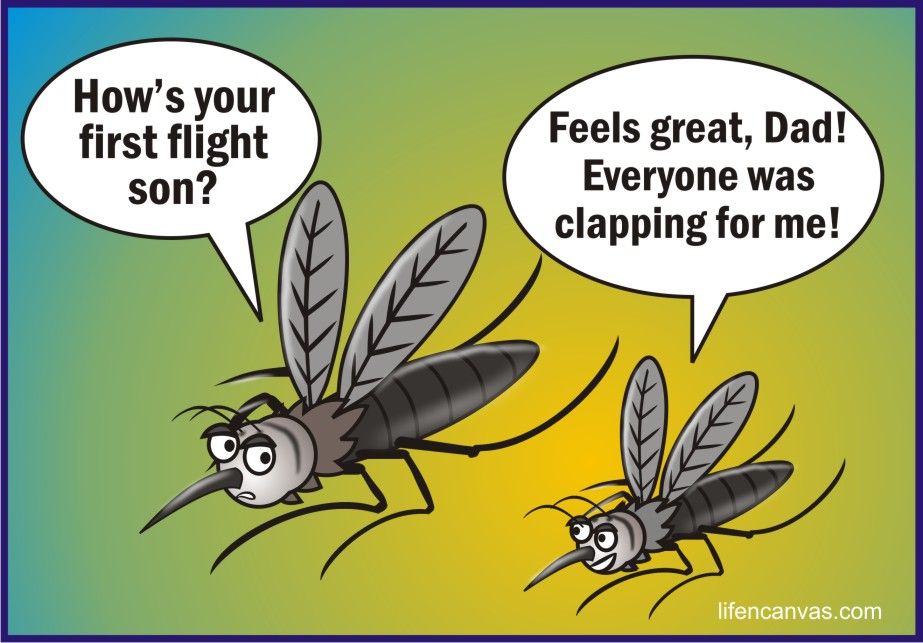Malaysia is set to be the source of the next global monkey malaria threat. Wait, what?!

- 401Shares
- Facebook328
- Twitter11
- LinkedIn11
- Email14
- WhatsApp37
You may not know it yet but Malaysia might be in the middle of a severe crisis. We don’t mean political crisis or societal crisis no, we mean health crisis. According to some reports from both international and local press, Malaysia is set to be the site of the world’s next global malaria threat.

In fact, not only are we set to be the site of the next malaria scare, it’s not even the usual kind of malaria. Instead, what we’re dealing with is… MONKEY MALARIA!
…Okay fine you’re probably not that scared right now so let’s first explain what’s up with monkey malaria.
Monkey malaria killed more Malaysians than normal malaria last year
Malaria that affects humans comes from five different types of parasites – P. falciparum, P. malariae, P. ovale, P. vivax and P. knowlesi. The first four of those parasites are the usual human malaria ones but the last one, P. knowlesi is a monkey-borne malaria that’s causing the trouble. Incidentally, we know-lesi (haha) that monkey malaria was on the rise thanks to a certain Malaysian researcher by the name of Dr Balbir Singh, which we’ve actually written about before.
But back to the monkey malaria. Despite P. knowlesi gaining some attention in 2004, there still seems to be a lack of action taken against it. In the last decade alone, Malaysia has seen over 15,000 cases of monkey malaria and around 50 deaths, with 3,600 infections and 11 deaths in just last year. To put this into context, only one Malaysian died of normal malaria last year.

Even Singapore, which the World Health Organisation (WHO) declared malaria free since 1982, recently reported several cases of monkey malaria, including a 14-year-old kid who contracted it following a school trip to Malaysia. The data also doesn’t take into account a super new variant of the monkey malaria called P. cynomolgi that appeared in five locals and 13 foreigners here last year. Govt officials believe that this new mutation has spread over the world due to air travel.
With an idea of how serious the issue is, you might be wondering how it goes around. Unfortunately, there aren’t any flying monkeys going around biting people. Instead, it’s our old friend doing the dirty work – mosquitoes. Specifically, the mosquito A. cracens, which are usually found where the monkeys are and carry the monkey malaria parasite.

Some of the symptoms usually seen in cases of monkey malaria include feelings of nausea, headaches, fever and flu signs. Meanwhile, within your body, blood platelet count starts decreasing the moment the infection gets into your bloodstream. The disease is fatal as the P. knowlesi parasite reproduces in your bloodstream every 24 hours or so, meaning if you don’t get treatment early, then well you’re probably joining Harambe in the afterlife.
Oddly enough, the WHO doesn’t put monkey malaria in its malaria elimination efforts. This is because they haven’t actually found enough proof that the monkey malaria can be transmitted within humans, and so haven’t placed it in the same category as the usual human malaria parasites. That is however not to say that it doesn’t happen, as researchers feel like it does, just that not as commonly as the other malaria types.

Now that we know what it is and how it happens, the next question then is perhaps… why is monkey malaria suddenly affecting so many Malaysians?
Deforestation is bringing monkeys closer and closer to humans
According to Kimberly Fornace, an epidemiologist (basically someone who studies diseases), the sudden rise in monkey malaria cases in Malaysia is linked to the deforestation that’s happening here. Fornace studied almost 2,000 people in Sabah and found that those who lived and worked near chopped down forests were more likely to have monkey malaria compared to other Sabahans living away from the forests.
“It feels almost like P. knowlesi follows deforestation,” – Kim Fornace, epidemiologist, as quoted by Malay Mail
We’ve probably heard of how bad the levels of deforestation in Borneo, but for it to possibly cause a global health crisis sounds straight from some B-grade horror movie. Unfortunately, it’s looking likely with rampant deforestation remaining a problem in East Malaysia. This is because as more trees get felled, more monkeys (and the mosquitoes that annoy them) move closer to human populations, leading to more cases of monkey malaria.

To get an idea of how much forest lands the monkeys have lost, back in the 1980s, Borneo as a whole had over three quarters of its land covered in forests. Today, only half of Borneo’s forest remains, and a study by the World Wildlife Fund predicted that Borneo will have less than a quarter of its forests left by 2020. Specifically in Sabah and Sarawak, the two states went from 15 million hectares of old-growth forests in the 70s to just over 10 million hectares left in 2015. We’ve even been ‘awarded’ the title of the country with the world’s highest deforestation rate in 2013, which just goes to show how bad things are for both man and monkey.


With no more trees to call home, the monkeys that carry the P. knowlesi parasite end up spending more time near humans, where there’s usually food and not that many predators. The A. cracens mosquito that carries the disease would also then be found nearer to humans. The species was rarely found among people in the 1990s but by the late 2000s made up over 60% of the mosquitoes that were found in orchards.

Our govt has responded tho, and according to them…
While there is a problem, the situation might not be as bad as it seems
The rise in monkey malaria cases in Malaysia is definitely something that the Ministry of Health is concerned about, but they’ve also pointed out that it might be due to improvements in diagnosis, allowing them to find more and more people with the disease.
“It is important to highlight that among the reasons for this increase were due to improvement in diagnosis capacity to differentiate knowlesi malaria from the other human malaria variants,” – Datuk Dr Noor Hisham Abdullah, Health Ministry director-general, as quoted by Malay Mail
Earlier in this article, we brought up Dr Balbir Singh, who in 1999 found out that a number of malaria cases in Sarawak were staying sick despite prolonged treatment. It was thanks to Dr Balbir who would go on to find out that we are actually extremely susceptible to monkey malaria.

Malaysia would later go on to incorporate better malaria detection methods in 2009, letting them detect monkey malaria more effectively compared to most other countries who rely on less advanced malaria detection methods. Rose Nani Mudin, head of the vectorborne disease sector in the MoH, echoes that statement.
“Maybe there is a genuine increase in (monkey malaria) cases. But with strengthening of surveillance, of course you would detect more cases,” – Rose Nani Mudin, as quoted by Science News
That being said, it’s not like the govt is only treating it as monkey business – far from it in fact. It has been running the Malaria Elimination Program since 2011, reducing human cases of malaria and increasing awareness about monkey malaria. The ministry also agrees that monkey malaria cases increased due to deforestation. As a response, they’ve already begun increasing surveillance and providing better facilities for diagnosis of malaria.

However, regardless of how serious the issue of monkey malaria is, if there’s one thing you need to do, it’s that….
You should stop monkeying around and prevent mosquitoes breeding near you
Let’s face it, a lot of us living in the big city probably haven’t really thought of malaria at all, let alone monkey malaria. Mosquitoes tho remain a huge problem even if we don’t live by the forests, as we’ve probably heard of dengue fever caused by the Aedes mosquito. To put it into context, while there were over 15,000 cases of monkey malaria over the past ten years, in the first half of 2018 alone, there were 32,435 dengue cases with 53 lives lost.

As such, it’s probably a good idea to listen to those ads and posters telling you to empty your flower pots and check for stagnant water. You wouldn’t want to end up in the hospital over dengue or malaria now, do you?
- 401Shares
- Facebook328
- Twitter11
- LinkedIn11
- Email14
- WhatsApp37



